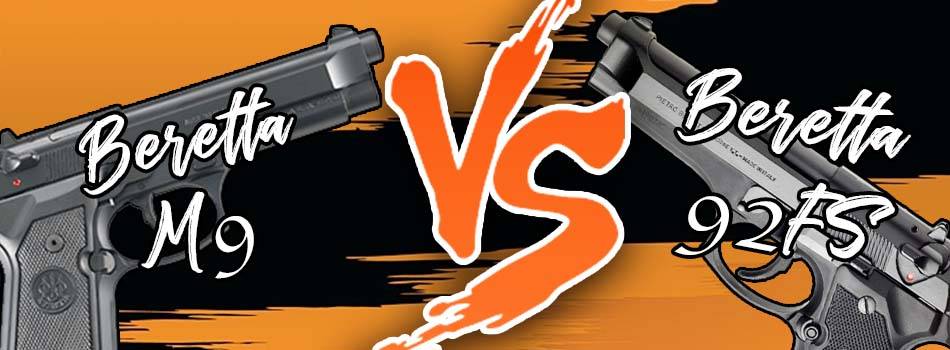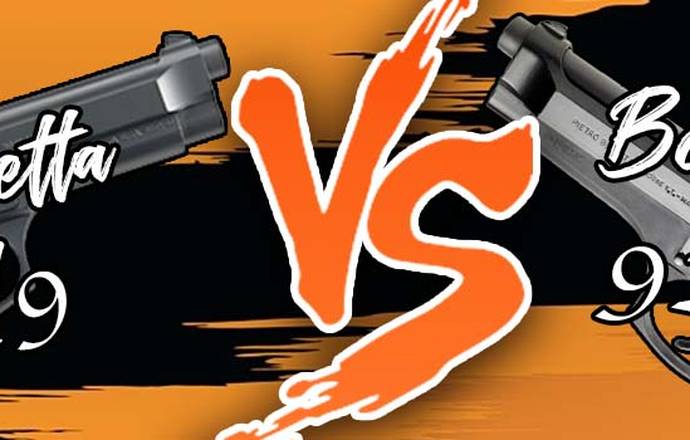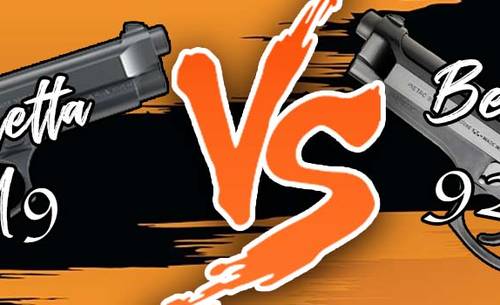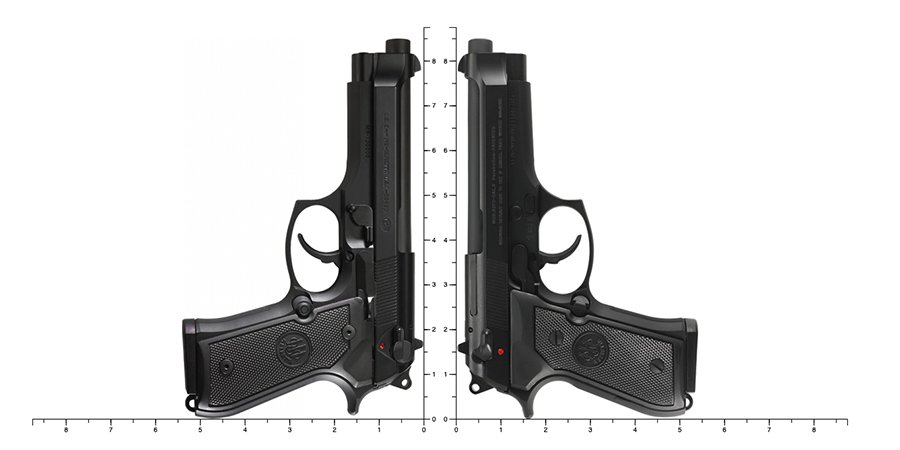


When you get to know firearms as well as I do, few names resonate with as much authority and history as Beretta. A question I get asked often is: is there any real difference between the Beretta M9 vs 92FS?
It’s easy to argue that both the Beretta M9 and Beretta 92FS stand as timeless icons of the gun world, each boasting a legacy of military service, law enforcement duty, and civilian popularity. As someone who has spent considerable time with both these pistols, I'm here to offer a comprehensive comparison.
This review aims to shed light on the design, performance, and suitability of these iconic Beretta pistols for various applications, providing insights to aid both seasoned enthusiasts and newcomers in making an informed choice between the Beretta M9 vs 92FS.
BERETTA M9 VS 92FS: DESIGN AND ERGONOMICS
When it comes to design, there’s no denying that the Beretta M9 and Beretta 92FS share striking similarities owing to their common lineage. Both pistols exhibit the classic Beretta profile, characterized by sleek lines and a timeless aesthetic. The frames are constructed from aluminum alloy, which balances durability with a relatively lightweight feel. However, there are subtle design differences worth noting.
The M9, originally designed for military service, features a straight backstrap, while the 92FS has a curved one. This seemingly minor variation can significantly impact how the gun feels in your hand. Personally, I've found the M9's straight backstrap offers a more natural point of aim, making it slightly easier to acquire targets quickly.
GRIP CONSIDERATIONS
Both models offer ample real estate for your hands, and the grip panels themselves have a great texture to enhance your control over the firearm. However, the 92FS provides a more rounded grip, which can be comfortable for extended shooting sessions. The M9, on the other hand, offers a flatter grip, which I know many other shooters prefer for a more secure hold. Grip almost always ultimately boils down to personal preference, and I appreciate that both models allow for customization with aftermarket grip panels.
BERETTA 92FS VS M9: ACTION AND FIRE MODES
One of the fundamental distinctions between the Beretta M9 and 92FS lies in their action and fire modes. Both pistols operate on the single/double action mechanism, but there are notable variations in how they handle it.
TRIGGER
The single-action (SA) mode allows for a lighter trigger pull, resulting in improved accuracy for well-aimed shots. The double-action (DA) mode, on the other hand, requires a longer and heavier pull, which can be advantageous in situations where a quick, instinctive shot is needed. Both pistols can be carried safely with a round in the chamber, thanks to their decocking safeties. When considering a weapon for my personal use, either the weapon has this feature, or it’s a non-starter.
The M9 has a traditional slide-mounted safety, while the 92FS employs a frame-mounted safety. Some shooters prefer the frame-mounted safety of the 92FS for its ease of use, especially in high-stress situations. Personally, I find the M9's slide-mounted safety to be slightly more intuitive, as it falls naturally under my thumb when I grip the pistol.
Your familiarity with these mechanisms is going to factor big here. If you've trained extensively with one, you’ll likely lean towards that model no matter what anybody says. I will say, however, that both actions are reliable, and the choice comes down to your training and comfort level. Whether it's the crisp single action or the first-shot long double action, both the M9 and 92FS offer versatility to meet your shooting needs.
BERETTA M9 VS 92FS: CALIBER AND AMMUNITION
Both the Beretta M9 and 92FS are chambered in the ubiquitous 9x19mm Parabellum caliber, a choice that carries both historical significance and practical advantages. The 9mm Parabellum round is renowned for its manageable recoil and versatility, making it a favorite among military, law enforcement, and civilian shooters alike.
For me, the 9mm cartridge strikes the right balance between stopping power and controllability—moderate recoil allowing for quick follow-up shots, which are crucial in high-stress situations.
This caliber is also widely available, making it relatively affordable for practice and self-defense purposes. Moreover, the 9mm Parabellum's widespread use ensures a diverse selection of ammunition types, including hollow points, frangible rounds, and target loads, catering to a broad spectrum of needs.
SHOOTING EXPERIENCE
In terms of shooting experience, the 9mm caliber enhances the overall usability of both the M9 and 92FS. Recoil is manageable even in rapid-fire scenarios, enabling accurate and controlled shooting. Whether you're a seasoned shooter or a beginner, the 9mm ammunition's ease of use can make a significant difference in your confidence and accuracy.
BERETTA M9 VS 92FS: MAGAZINE CAPACITY
When it comes to magazine capacity, the Beretta M9 and 92FS offer similar options, typically accommodating 15 rounds in their standard magazines. This generous capacity provides a comfortable margin in both self-defense and duty applications, allowing for multiple engagement opportunities before the need to reload.
The implications of this magazine's capacity are particularly evident in self-defense scenarios. Having 15 rounds readily available can be a confidence booster, especially when facing multiple threats or in a crunch situation where accuracy may be compromised. Law enforcement professionals often appreciate this capacity, as it can be a decisive factor in life-or-death encounters.
In my personal experience, the magazine size strikes a sweet spot between firepower and practicality. It allows for sufficient ammunition without excessively increasing the weight and bulk of the firearm. Additionally, it minimizes the frequency of reloading, which can be a BIG factor in a firefight.
BERETTA 92FS VS M9: SPECS AND PORTABILITY
Let's continue with a quick breakdown of the main specs of Beretta 92FS VS Beretta M9, shall we?
|
|
Beretta M9 |
Beretta 92FS |
|
Caliber |
9x19mm (9mm Luger) |
9x19mm (9mm Luger) |
|
Action |
Single/Double |
Single/Double |
| Weight (empy mag) |
34.4 oz |
34.4 oz |
|
Overall Width |
1.4 inch |
1.5 inch |
|
Overall Length |
8.54 inch |
8.5.inch |
|
Barrel Length |
4.92 inch |
4.9 inch |
|
Magazine |
Double stack |
Double stack |
|
Mag Capacity |
15+1 rounds (standard mag) |
15+1 rounds (standard mag) |
| MSRP | $679.00 |
$699.00 |
Spot the difference? Yeah, neither can I. Butkus. Pretty much a zero difference—on paper, anyway.
Beretta M9 VS 92FS - Size Chart

Source: handgunhero.com
CONCEALABILITY AND PORTABILITY
Size goes hand in hand with concealability. And concealability largely depends on holster choice, and both the M9 and 92FS benefit from a wide array of holster options. As someone who has carried both models, I've found that selecting the right holster plays a pivotal role in ensuring comfort and concealment.
Inside-the-waistband (IWB) holsters work well for concealed carry, while outside-the-waistband (OWB) holsters are ideal for open carry and duty use. Ultimately, the choice between the M9 and 92FS may come down to your specific carry needs and how well you can conceal them.
BERETTA M9 VS 92FS: CONCLUSION
The choice between the Beretta M9 and the Beretta 92FS is not merely a matter of personal preference but rather one of aligning the characteristics of these venerable pistols with your specific needs. Both handguns share a lineage rich in history, design, and performance, yet they do have their subtle differences.
The only major difference I think you’ll find is the M9's straight backstrap may appeal to those seeking a more natural point of aim and enhanced recoil control. Meanwhile, the 92FS offers a curved backstrap, making it comfortable for extended use and potentially ideal for those prioritizing carry comfort.
When it comes to action and fire modes, both models excel, offering single and double-action capabilities. Your preference may lean towards one based on training and familiarity, but rest assured that both mechanisms are reliable.
The 9x19mm Parabellum caliber, standard in both models, is a testament to versatility and effectiveness, enhancing your shooting experience with manageable recoil and a wide array of available ammunition types.
In conclusion, both the Beretta M9 and 92FS represent the pinnacle of Beretta's craftsmanship and reliability, and your decision should revolve around your unique requirements and preferences.
Are you intersted in reading more comparisons of Beretta 92FS? Here are some, with Sig P226. If you are itnerested in delving deeper into problems then read our Beretta 92FS problems article
Beretta M9 vs 92fs: Best holsters
Selecting the right holster is paramount when choosing between the Beretta M9 and 92FS. For concealed carry fans, our inside-the-waistband (IWB) options, like the steel clip IWB holster for Beretta M9, make your favorite friend ready when you are. If you’ve gone for the military version, our holsters for Beretta 92FS can’t be beaten.
Personal recommendations may vary, but these holsters provide a starting point for your selection. Factors like holster material, retention level, and carry position should align with your preferences and needs.
Always practice safe holster use and consider additional training for proficient drawing and reholstering, regardless of the holster choice.






